- Home
- Gustave Flaubert
Madame Bovary
Madame Bovary Read online
MADAME BOVARY
Provincial Ways
GUSTAVE FLAUBERT
Translated with an Introduction and Notes by
LYDIA DAVIS
PENGUIN CLASSICS
an imprint of
PENGUIN BOOKS
PENGUIN CLASSICS
Published by the Penguin Group
Penguin Books Ltd, 80 Strand, London WC2R 0RL, England
Penguin Group (USA) Inc., 375 Hudson Street, New York, New York 10014, USA
Penguin Group (Canada), 90 Eglinton Avenue East, Suite 700, Toronto, Ontario, Canada M4P 2Y3 (a division of Pearson Penguin Canada Inc.)
Penguin Ireland, 25 St Stephen’s Green, Dublin 2, Ireland (a division of Penguin Books Ltd)
Penguin Group (Australia), 250 Camberwell Road, Camberwell, Victoria 3124, Australia (a division of Pearson Australia Group Pty Ltd)
Penguin Books India Pvt Ltd, 11 Community Centre, Panchsheel Park, New Delhi – 110 017, India
Penguin Group (NZ), 67 Apollo Drive, Rosedale, North Shore 0632, New Zealand (a division of Pearson New Zealand Ltd)
Penguin Books (South Africa) (Pty) Ltd, 24 Sturdee Avenue, Rosebank, Johannesburg 2196, South Africa
Penguin Books Ltd, Registered Offices: 80 Strand, London WC2R 0RL, England
www.penguin.com
First published, in six instalments, 1856
This translation first published in the United States of America 2010
This translation first published in Penguin Classics 2010
Translation and introduction copyright © Lydia Davis, 2010
All rights reserved
The moral right of the translator has been asserted
Except in the United States of America, this book is sold subject to the condition that it shall not, by way of trade or otherwise, be lent, re-sold, hired out, or otherwise circulated without the publisher’s prior consent in any form of binding or cover other than that in which it is published and without a similar condition including this condition being imposed on the subsequent purchaser
ISBN: 978-0-141-96685-4
CONTENTS
Introduction
Suggestions for Further Reading
Chronology
MADAME BOVARY
PART I
PART II
PART III
Notes
INTRODUCTION
Readers who do not want to know the details or the denouement of the plot should read this introduction only after they have read the novel.
“Yesterday evening, I started my novel. Now I begin to see stylistic difficulties that horrify me. To be simple is no small matter.” This is what Flaubert wrote to his friend, lover, and fellow writer Louise Colet on the evening of September 20, 1851, and the novel he was referring to was Madame Bovary. He was just under thirty years old.
Picture a large man, handsome though fleshy and prematurely balding, with clear blue-green eyes and a voice that could be loud and gruff (he was known to “bellow,” both while trying out his sentences and while having dinner with his friends), bent over his desk, working by lamplight with a goose-quill pen (he abhorred a metal nib). He writes very slowly and painfully, drafting—and revising—much more material than he will keep in the end. His concentration is deep, intense, and enduring; he stays with his work for many hours at a time. His mother will sometimes leave the house all afternoon to do an errand in town and find him, on her return, in exactly the same position as when she left.
Generally he starts work in the early afternoon and works until the early hours of the morning, breaking only for dinner. His study is a spacious room on the second floor that looks out past a tulip tree over a tow-path to the river. Despite the many hours of meticulous work, he often then, at one or two in the morning, writes a long letter to Colet, perhaps as a form of release. It is thanks to these letters, which continued until their breakup two and a half years later, that we can follow so closely the progress of his work on the novel.
Because he discards a good deal of material, and prunes back severely the material he keeps, he produces very few finished pages—he variously reports one page per week, one every four days, thirteen pages in three months, thirty pages in three months, ninety pages in a year. (This in contrast with the ease of his first version of The Temptation of Saint Anthony, drafted earlier—five hundred pages in eighteen months, he said.) Yet he makes steady progress. His closest friend, the poet Louis Bouilhet, comes almost without fail every Sunday, when Flaubert reads aloud to him what he has done that week. Bouilhet responds, often severely: he likes it very much, or Flaubert should cut further, or there are too many metaphors.
Flaubert spent about four and a half years writing the novel, staying closeted with his work for months at a time, only periodically taking the train to Paris for some days of city life and sociability with friends, though he did not always stop working when he was there.
He finished it sometime in March of 1856; it was then accepted for publication by his longtime friend Maxime Du Camp, one of the editors of La Revue de Paris, and was published serially in that journal in six installments from October 1 to December 15. Henry James describes coming upon it in this form “when a very young person in Paris” and picking it up “from the parental table.” “The cover … was yellow, if I mistake not.” He recalls “taking it in with so surprised an interest,” as he read it “standing there before the fire, my back against the low beplushed and begarnished French chimney piece.”
Although certain scenes had been cut from this version as a precaution—which perhaps had the opposite effect, of arousing suspicions—the government brought charges against it for being a danger to morality and religion. The trial took place on January 29, 1857, and lasted one day; Flaubert and the magazine were acquitted a week later. When the book appeared as a single volume that April, it bore a second dedication, to Marie-Antoine-Jules Sénard, the forceful and eloquent Rouen lawyer who had defended him.
The very approach that made the novel vulnerable to prosecution by the Second Empire government was what made it so radical for fiction of its day—it depicted the lives of its characters objectively, without idealizing, without romanticizing, and without intent to instruct or to draw a moral lesson. The novel, soon to be labeled “realist” by his contemporaries, though Flaubert resisted the label, as he resisted belonging to any literary “school,” is now viewed as the first masterpiece of realist fiction. Yet its radical nature is paradoxically difficult for us to see: its approach is familiar to us for the very reason that Madame Bovary permanently changed the way novels were written thereafter.
Flaubert was born on December 12, 1821, in his family’s apartment in a wing of the hospital of which his father was chief surgeon, in the port city of Rouen. He showed an interest in writing from a very early age and published his first work at sixteen but was persuaded by his father to attend law school. Suffering his first epileptic attack at age twenty-three, he was forced (though without reluctance) to give up his law studies and from then on devoted himself almost exclusively to writing. By that time he had already begun the first version of his novel A Sentimental Education.
The family had acquired a large, comfortable house overlooking the Seine in the hamlet of Croisset, a few miles from Rouen, and it was here that he settled. After the death of both his father and his sister in 1846, the household was to consist, for many years, of Flaubert, his mother, and his little niece Caroline, whom he helped to raise, as well as the servants who looked after them. Aside from some traveling, some vacations by the seaside at Trouville, and some intervals of living in Paris, he spent most of the rest of his life at Croisset.
Drawn to the exo
tic, he wrote a draft of another novel, The Temptation of Saint Anthony, but suspended work on it in 1849 when Bouilhet and Du Camp so disliked it, after a marathon four-day reading, that they suggested he throw it in the fire. He did not abandon either of his early novels, however: he was to finish A Sentimental Education in 1869 and The Temptation of Saint Anthony in 1872.
He had, therefore, written a great deal, though to the literary world he was unknown, before he began what was to be his first published novel.
To counter Flaubert’s tendency to wax lyrical and effusive in response to exotic materials, Bouilhet suggested he take as subject for his next novel something quite mundane. The story of Madame Bovary is based, in fact, on two local dramas: the adultery and subsequent suicide of one Delphine Delamare, the wife of a local public health officer, and the disastrous spending habits and ultimate financial ruin of Louise Pradier, the wife of a sculptor Flaubert knew personally. A third influence on the novel was the regional fiction of Balzac, whom Flaubert greatly admired. The book would be about not only a woman whose character fatally determined the course of her life but also the place in which she lived and its confining effect on her. After first considering Flanders as a setting, Flaubert settled on his native Normandy, so familiar to him.
The main action of the novel unfolds squarely within the July Monarchy of Louis-Philippe (1830–48), an interval of relative calm in French history and, for Flaubert, the years that had embraced his adolescence and early adulthood. Unlike A Sentimental Education, the novel contains little hint of political unrest: here the drama is domestic and local, and the larger outside world hardly intrudes.
It was during the reign of Louis-Philippe, who was known as the roi bourgeois, or “Citizen King,” because of his bourgeois manner and dress, that the middle class was most explicitly defining itself as distinct from the working class and the nobility. And one of Flaubert’s motivating forces in his approach to the material of the novel was his scorn for the bourgeoisie, though he readily included himself among them. What he despised, really, was a certain type of bourgeois attitude—later codified in his Dictionary of Accepted Ideas. It included certain traits such as intellectual and spiritual superficiality, raw ambition, shallow culture, a love of material things, greed, and above all a mindless parroting of sentiments and beliefs. He delighted in attacking this kind of thinking wherever he witnessed it: his letters are full of jabs and gibes, whether against a pompous cousin visiting Croisset for the day or a fellow writer in Paris who prided himself on being invited to dine with a government minister.
The novel is full of markers of the culture of Flaubert’s time that we in our time may not recognize as such: La Chaumière dance hall in Paris; Pompadour clocks and statuettes; the poet Béranger; the novelist Sir Walter Scott; fireworks; tourist attractions in Italy; a plethora of English importations, including horse racing and the casual use of English words and expressions. Flaubert is holding up a mirror to the middle- and lower-middle-class world of his day, with all its little habits, fashions, fads. French readers who belonged to that world would recognize themselves (or their parents) and either blush or laugh complicitly: they, or their parents, might play whist in the evening (as did the king himself), or have a similar piece of coral on the mantelpiece or the same print on the parlor wall; perhaps it was their aunt who, like Emma, coveted a tilbury—that fashionable English carriage—or a mouth-rinsing bowl on the dinner table; or perhaps a self-important uncle, like Homais, hoped to be awarded the cross.
It isn’t as clear to us, reading the novel in the twenty-first century, that these were not necessarily thoughtful individual choices but rather symptoms of a blind adherence to conventional—and often questionable—taste. But what Flaubert called stupidity was not limited to the bourgeoisie. Or rather, if he had a lifelong habit of watching for stupidity and relishing examples of it, he found it in “all of humanity”; all of humanity was bourgeois. He could not shave, for instance, without laughing at the stupidity of it.
In a letter written to Colet as he was composing the first meeting of Emma and Léon, he explains that what interests him is the grotesqueness of a supposedly lofty conversation between two sensitive, poetic individuals that is, in fact, wholly made up of clichéd ideas. He realizes early on that he has set himself a formidable task: to take this grotesqueness as his subject, to write a novel about shallow, unsympathetic people in a dreary setting, some of whom make bad choices and come to a horrific end. There will be no romanticizing the subject—in fact, the whole project is opposed to the romantic. The heroine, infatuated with romanticism, comes to grief because of it—because of her craving for impossible dreams, her refusal to accept the ordinariness of her life and its limited possibilities for happiness.
Nor is there any moralizing on the part of the author—one reason the novel was so vulnerable to attack by the government. The story contains no sermon to point out its moral; it has no “good” moral exemplar to offer in contrast to the “bad” woman that Emma is. The author does not condemn her behavior but, rather, may even have some sympathy for her; nor does he pass judgment on any of the other characters. The story is uncompromising: the heroine commits adultery and then suicide; her good husband dies, too; her innocent child is fated to have a hard life; the evil moneylender who has been the instrument of Emma’s downfall prospers; the conniving, hypocritical, and disloyal “friend,” Homais, is rewarded with a coveted medal.
Flaubert chose to create characters who are less than admirable and to treat them with ironic objectivity—he remarks in another letter, as he works on the scene between Emma and Léon, “This will be the first time, I think, that one will see a book that makes fun of its young leading lady and its young leading man.” Yet he goes on to say that “irony takes nothing away from pathos.” Which is echoed by Vladimir Nabokov in his lecture on the novel: “The ironic and the pathetic are beautifully intertwined.”
Flaubert wants his readers to be moved by the characters. He states explicitly, for instance, in the case of Charles’s grief, “I hope to cause tears to flow with the tears of this one man.” Again, in another letter: “In my third part, which will be full of comical things, I want people to cry.”
And although there is hardly a sympathetic character among them—some readers may feel that possible exceptions to this are Emma’s father; or the pharmacist’s assistant, Justin; or Charles himself—we do feel at least glimmers of sympathy or liking, at moments. It may be true that every one of Homais’s statements is a completely conventional “accepted idea,” yet it is hard not to enjoy his cunning, his enterprise, his intellectual explorations, and even to agree with him sometimes. One cannot help feeling some respect for Emma’s bravery at the end, her moment of true affection for Charles, her interest in her own dying: “She was observing herself curiously, to see if she was in pain. But no! Nothing yet. … ‘Ah! It’s a small thing, really—death!’ she thought; ‘I’ll fall asleep, and everything will be over!’” We are indeed moved, though perhaps not to the extent Flaubert may have hoped—the prevailing irony may distance us too much from the story, even as it enhances its dramatic horror.
Nor is he himself unaffected by the characters. “I am in their skin,” he says—though he later qualifies that skin as “antipathetic.” We know that he sometimes found himself weeping as he wrote and that he so identified with Emma during her last days that he was physically ill.
Flaubert’s aim was to write the novel “objectively,” leaving the author out of it. Although Madame Bovary is filled with political and social detail reflecting Flaubert’s very strong views (his friend Émile Zola describes how Flaubert could not tolerate being contradicted in an argument), his technique is to present the material without comment, though occasionally a comment does slip in. To report the facts objectively, to give a painstaking objective description—of a ridiculous object, for instance—should be comment enough. Flaubert remarks in another letter to Colet, of the scene in wh
ich Emma goes to the curé for help, “The episode is to have at most six or seven pages without a single reflection or explanation coming from the author (all in direct dialogue).”
In place of the author’s comment, then, the details of the scenes and the acute psychological portraits must convey everything—and, for Flaubert, direct dialogue, too, functioned to portray the characters more than to move the plot forward. Detailed description would bring the reader into the presence of the material. To be effective, the details must be closely observed, carefully chosen, precise, and vivid, as in the description of Emma’s bridal bouquet after she has thrown it into the fire: “The little cardboard berries burst open, the binding wire twisted, the braid melted; and the shriveled paper petals, hovering along the fireback like black butterflies, at last flew away up the chimney.”
If the novel is to move or interest a reader, Flaubert will have to transform what he sees as a sordid world, wholly through the power of his style, into a work of formal and stylistic beauty—all the while writing it in a manner against his own natural inclinations. He says outright many times that he is afraid he won’t pull it off: everything must depend on the style.
In keeping with his plain, almost clinical approach to the material, he schooled himself to be very sparing with his metaphors. Often enough, in his intensive revising, the version he cut out was more lyrical than the one he let stand. Marcel Proust, for one, writing more than sixty years after the publication of the novel, regretted the absence of metaphor, since he believed, as he said, that “only metaphor can give a sort of eternity to style.” But he admitted that there was more to style than metaphor alone.
Proust goes on to say that in all of Flaubert there is not a single beautiful metaphor. Yet here is another lovely comparison to a butterfly: after she has given herself to Léon for the first time, in the closed carriage that careens through Rouen, Emma tears up the note of rejection she had uselessly written him, and “a bare hand passed under the little blinds of yellow canvas and threw out some torn scraps of paper, which scattered in the wind and alighted, at a distance, like white butterflies, on a field of red clover all in bloom.”

 Bouvard and Pecuchet
Bouvard and Pecuchet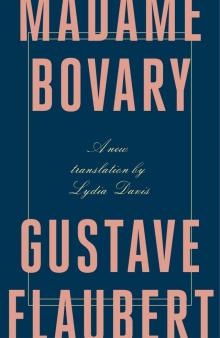 Madame Bovary
Madame Bovary The Temptation of St. Antony
The Temptation of St. Antony Bouvard and Pécuchet: A Tragi-comic Novel of Bourgeois Life, part 1
Bouvard and Pécuchet: A Tragi-comic Novel of Bourgeois Life, part 1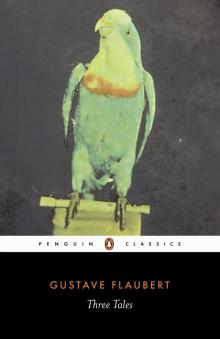 Three Tales
Three Tales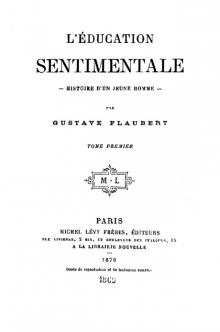 Education sentimentale. English
Education sentimentale. English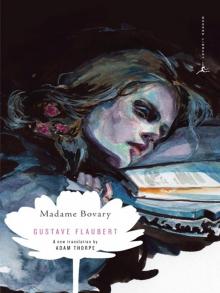 Madame Bovary (Modern Library)
Madame Bovary (Modern Library)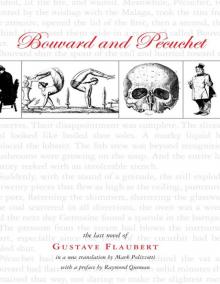 Bouvard and Pécuchet: A Tragi-comic Novel of Bourgeois Life, part 2
Bouvard and Pécuchet: A Tragi-comic Novel of Bourgeois Life, part 2 Sentimental Education; Or, The History of a Young Man. Volume 1
Sentimental Education; Or, The History of a Young Man. Volume 1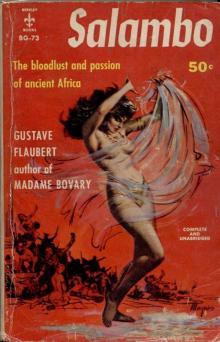 Salammbo
Salammbo Memoirs of a Madman and November
Memoirs of a Madman and November Complete Works of Gustave Flaubert
Complete Works of Gustave Flaubert